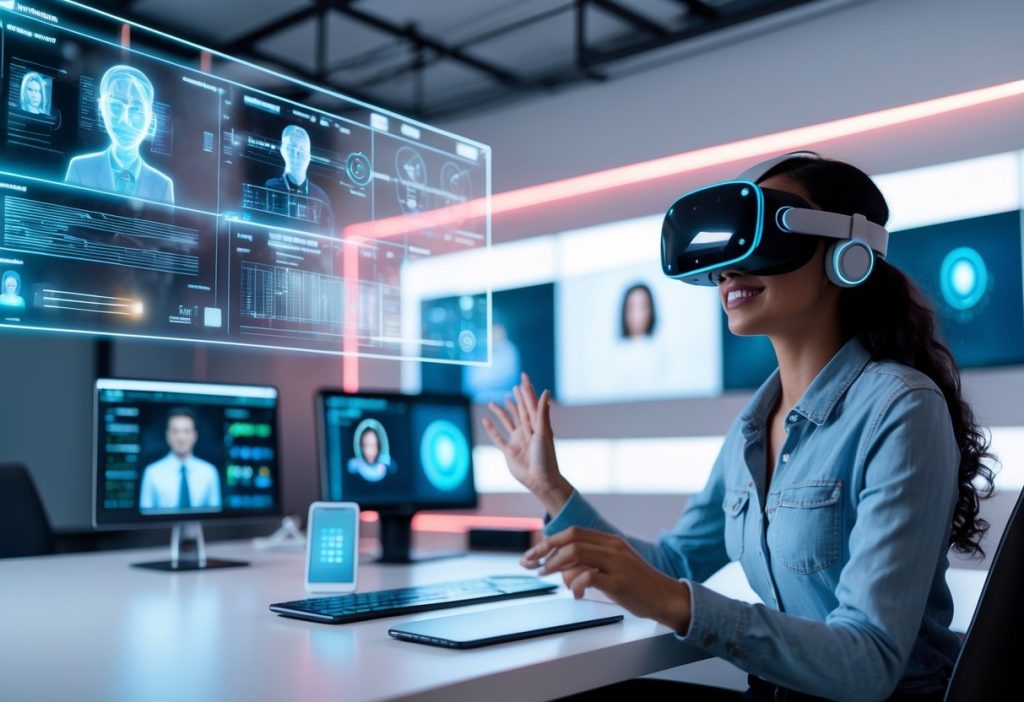AI and VR Transformations in the Live Cam Experience

AI and VR are transforming the live cam landscape, making digital connections more vivid and, dare I say, strangely intimate. These evolving tools boost realism, shape personal interactions, and let viewers and performers connect in ways that would’ve sounded like sci-fi a decade ago.
Automation and immersive visuals are just the start. Intelligent feedback systems are making every session feel less like a broadcast and more like a genuine exchange.
AI-Powered Chat Bots and Real-Time Interactions
AI chat bots now handle a surprising chunk of conversations during live cam sessions. They greet people, answer the easy stuff, and keep things rolling when the model’s got their hands full.
Honestly, it’s helpful, performers can focus on being present, while the bots keep the crowd from drifting off. The bots aren’t just basic scripts anymore, either.
Machine learning lets them pick up on language quirks and adjust their tone or style, depending on who they’re chatting with. If someone’s a regular, the bot remembers and throws in a familiar greeting.
Some platforms go further, using emotion recognition to tweak replies in real time. Conversations feel more human, but there’s a tradeoff, privacy and consent become bigger concerns when all that chat data is being analyzed.
| Benefit | Description
|
|---|---|
| Efficiency | Automates repetitive or simple interactions |
| Personalization | Adjusts tone and responses to individual viewers |
| Consistency | Keeps engagement up when the performer is busy |
VR Integration and Immersive Viewer Engagement
Virtual Reality is pushing live cam experiences far beyond the old flat-screen routine. Instead of passively watching, viewers can step into a 3D space that feels almost real, sometimes eerily so.
AI comes into play here, too. It tracks gestures and expressions so models’ movements look smoother and more believable.
Some setups even adjust lighting or camera angles on the fly, based on how viewers react. It’s a clever way to keep things interactive and dynamic.
There’s experimentation with AI-driven avatars that mimic real performers. That opens up a can of worms, how do you know what’s real, and does it matter?
360-Degree Cameras and Enhanced Perspectives
360-degree cameras are giving viewers more control than ever. Instead of being stuck with whatever angle the site picks, you can look around the entire environment.
Paired with VR headsets, it’s surprisingly immersive. AI tools help by stabilizing the video, improving lighting, and even shifting the focus to whatever’s most interesting at the moment.
Some platforms use AI to detect key actions and reframe the shot automatically. Performers can focus on what they do best, while the tech keeps everything looking sharp.
It’s not just about flash, either. The flexibility and sense of presence really do mimic real-world interaction, all while keeping things safe and private.
The Competitive Landscape: The AI and VR Arms Race

There’s a fierce arms race in AI and VR, with tech giants and startups all scrambling for the next big leap. The speed of innovation is honestly dizzying, and it’s upending how interactive experiences, especially live cams, are built and monetized.
Major players like NVIDIA, Microsoft, Meta, and Google are all in the mix. NVIDIA’s GPUs power much of the AI hardware, while Microsoft and Google are duking it out with cloud-based AI tools and immersive streaming.
Meta is betting big on VR ecosystems, focusing on lifelike avatars and spatial computing. Smaller companies like Varjo and Pimax are pushing high-res headsets and eye-tracking, while nimble startups try out new ways to personalize live cam sessions with AI.
| Company | Core Focus | Competitive Edge
|
|---|---|---|
| NVIDIA | AI chips & rendering | Hardware performance |
| Meta | VR ecosystems | Immersive social spaces |
| Microsoft | Cloud AI & mixed reality | Enterprise integration |
| AI models & AR tools | Data and scale |
These companies are setting the pace for next-gen live cam systems. It’s a wild mix of infrastructure and user experience innovation.
Global Competition and Regulatory Influences
The race isn’t just corporate. Countries like the U.S., China, and the EU are pouring money and policy muscle into AI and VR leadership.
The EU’s AI Act, for instance, has strict rules for data use and algorithm transparency. That’s shaping how immersive tech is built and rolled out worldwide.
Regulations now cover privacy, content moderation, and cross-border data. The challenge is keeping innovation alive without letting trust or digital rights fall by the wayside.
Upgrade Cycles and Technological Advancements
This field moves fast. Every new GPU, headset, or neural net brings real improvements in speed and realism, especially for live cam setups.
VR hardware is getting lighter and more comfortable, with higher refresh rates and wireless options. AI is handling everything from background generation to real-time translation and adaptive lighting.
The lines between AI and VR are blurring. Agentic systems now automate camera control, scene creation, and even audience interaction, cutting down on grunt work and opening up creative possibilities.
Deepfakes and Synthetic Media: Risks and Opportunities
AI and synthetic media are shaking up live cam environments in ways that are both exciting and a little unnerving. Visual quality and realism are way up, but so are the risks around security, privacy, and ethics.
Deepfake Technology in Live Cam Content
Deepfake tools are now able to generate facial movements, voices, and body gestures that look shockingly real, sometimes in real time. Performers can use digital doubles or avatars that mimic their every move.
Some creators use synthetic overlays to stay anonymous or spice up their shows with AI-driven filters and virtual characters. Combined with 360-degree video and VR, it’s a recipe for next-level immersion.
But here’s the catch: deepfakes can be abused. Using someone’s likeness without their okay can wreck reputations and privacy. The speed at which fake media spreads makes it even trickier to manage.
As these tools get easier to use, keeping live cam spaces authentic and safe is a growing challenge.
Ethical and Safety Considerations
Synthetic media blurs the lines around consent and identity. When AI-generated personas look human, viewers might not realize they’re interacting with a digital creation.
Performers who use AI avatars or voice synthesis should be up front about it. It’s only fair, privacy matters, but so does honesty.
There’s another layer of risk: AI systems trained on personal data can reproduce private features without permission. For models, that’s a real worry. Platforms need solid policies and smarter verification to make sure everyone involved actually consents before anything goes live.
Detection and Countermeasures
Spotting deepfakes isn’t easy. Machine learning models hunt for digital inconsistencies, but as fakes get better, so do the tools to catch them.
Governments and platforms are starting to crack down, with new rules and requirements to label AI-generated content. It’s a start, but the cat-and-mouse game isn’t ending anytime soon.
Collaboration across tech, regulation, and content platforms will be key if we want live cam spaces to stay open, safe, and trustworthy.
User Experience and Model Performance Enhancements
AI and VR are changing the way users and models interact on live cam platforms, making everything feel more personalized and responsive. Real-time data processing and adaptive feedback are making sessions smoother for everyone involved.
Adaptive Personalization Through AI
Modern AI systems learn from every viewer’s actions, what they click, how they chat, even how long they stick around. The tech adjusts recommendations, lighting, and camera angles on the fly, so each session feels tailored without endless manual tweaks.
Machine learning sifts through chat tone, reaction speed, and engagement time to predict what’ll keep someone interested. It’s not perfect, but it’s getting impressively close.
Examples of adaptive tools:
- AI-powered chat bots that actually sound like people, not robots.
- Emotion recognition that shifts the mood or visuals as needed.
- Smart lighting systems that react to the vibe in the room.
All of this helps models stay authentic and keeps viewers coming back. The more people use these platforms, the smarter the personalization gets, sometimes eerily so.
Performance Metrics and Analytics for Live Cams
When it comes to evaluating Live Cams, we look at a mix of technical and behavioral indicators. Technical aspects like frame rate, latency, and syncing for 360-degree camera feeds matter a lot.
Then there are behavioral insights: how long people stick around, how often they message, and whether they come back for more. These tell us what’s actually working, or not, on a human level.
| Metric Type | Example | Purpose
|
|---|---|---|
| Technical | Latency under 100ms | Ensures smooth VR streaming |
| Behavioral | Average session duration | Indicates viewer satisfaction |
| AI Quality | Response accuracy of chat bots | Measures conversational realism |
Mixing these numbers together lets us spot the rough patches, like VR lag or chatbot hiccups, and tweak things as needed. Sometimes, deep learning models even help us predict when the crowd will show up, so we can keep the stream going strong without annoying interruptions.
Privacy and Consent in AI-Enhanced Live Cams
With Live Cams leaning more on AI, privacy and consent have become really important. We make sure it’s obvious when artificial intelligence is doing its thing, like a chatbot reply or when emotion detection is in play.
User data, including anything picked up by VR gear, gets encrypted and locked down tight. Only those who need it can access it.
There are also consent dashboards, so people can decide what they’re comfortable sharing, whether it’s camera access, data collection, or AI-powered analysis. If you ask us, giving users this kind of control is just common sense.
These steps help keep trust alive, even as immersive tech like deepfakes and 360-degree video keeps evolving. It’s about making sure everyone’s clear on how their info is used to improve the experience.
For more on how emotion recognition works in these spaces, check out this in-depth article. And if you’re curious about eco-friendly streaming, here’s a solid resource on virtual reality webcams for smart homes.
Challenges and Future Trends in Live Cam Technology
AI and VR are shaking up the world of Live Cams, but it’s not all smooth sailing. There are questions about safety, ethics, and the nuts and bolts of making all this work at scale.
We’re constantly weighing how to handle data responsibly and minimize the environmental impact of all this streaming. It’s a balancing act as we move toward even more immersive, real-time connections.
Balancing Innovation and Regulation in Live Cam Platforms
AI-powered platforms, think facial recognition, motion tracking, or automated moderation, have made Live Cams more interactive and safer for users. But, they also bring up real concerns about privacy and consent.
Governments and organizations are stepping in with new rules on how data gets stored, how algorithms are explained, and how biometrics are used.
To keep up, developers need to build systems that check both the technical and ethical boxes. That means things like clear consent steps, strong encryption, and AI models that can be audited if needed.
| Key Focus | Example Practice
|
|---|---|
| Data Protection | End-to-end encryption |
| Transparency | Public AI model documentation |
| User Rights | Opt-in facial recognition |
Honestly, it’s a group effort, developers, regulators, and users all have to pull together to make sure progress doesn’t come at the cost of privacy or fairness.
Sustainability and Accessibility in Live Cam Streaming
High-res video and VR streaming use a ton of energy and bandwidth. Running several 4K or 3D streams at once can really push data centers and drive up emissions.
So, we’ve got to get creative: energy-efficient codecs, edge computing, and servers that run on renewables are all on the table. It’s not just about the tech, it’s about the planet, too.
But there’s more. Not everyone has super-fast internet or the latest VR headset. That’s why adaptive streaming, low-latency compression, and making things work across devices are so important.
To make Live Cams more welcoming, we’re also seeing AI-based captions, translations, and interfaces that adapt for people with different needs. The goal? Let more folks join in, no matter their setup.
Predictions for Next-Generation Live Cams
Thinking about where live cams are headed? The next wave is almost certainly going to mix AI-driven personalization with fully immersive VR spaces. Imagine cameras that just know how to tweak the lighting, sharpen the focus, or pick the best angle, all on their own, in real time.
It’s not just about the tech, though. There’s talk of AI-powered avatars stepping in for users, letting people interact in shared digital worlds that feel surprisingly real.
Thanks to 5G and edge computing, latency is dropping fast. That means you could soon watch multi-angle streams that keep up with you, no awkward delays.
We’re also seeing hints of modular camera setups designed to play nice with your smart home gear. Whether it’s for streaming, teaching, or just keeping in touch, these tools are getting more flexible.
Honestly, it’s hard not to be curious about how live video will keep evolving. For anyone interested in a deeper dive, Wired has a solid overview of what’s coming, and there’s a great breakdown of VR trends at Statista.
With these advances, sharing real-time experiences could feel more personal than ever. But as always, there’s a lot to think about, privacy, control, and keeping things ethical as the tech gets smarter.
